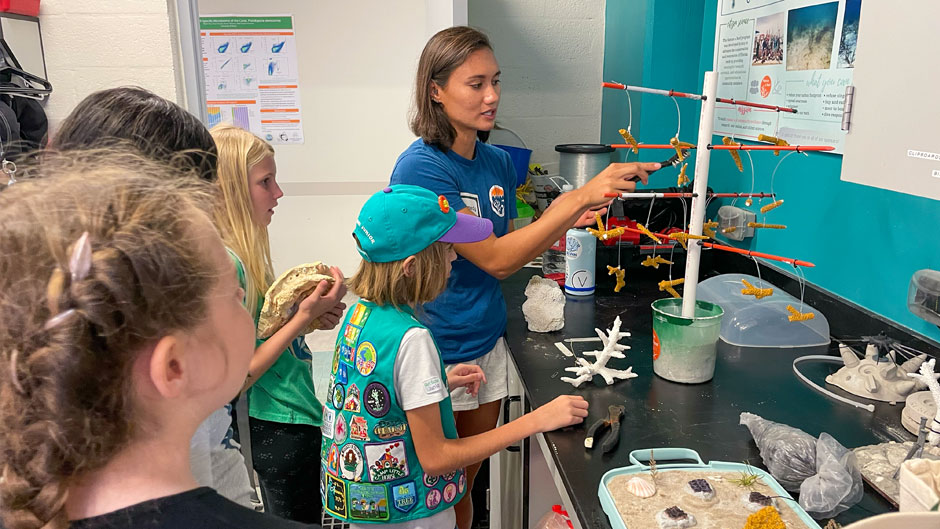At just 10 years old, Olivia Antillon-Galvan already has her sights set on becoming a quantum physicist or an astronaut one day. Annika Wardlaw, 11, wants to be a heart and lung surgeon. Now, both girls are starting to consider other areas of science.
“Today really made me want to go into marine biology,” said Wardlaw, of South Miami, as Antillon-Galvan grinned and nodded in agreement.
The two were among the 30 who were part of the Girl Scouts of Tropical Florida group, ages 10 to 18, who visited the University of Miami Rosenstiel School of Marine, Atmospheric, and Earth Science on Saturday for the 19th annual Women and Girls Exploring Earth Sciences Day.
The event was spearheaded by one of the Rosenstiel School’s first tenured female faculty members, Rana Fine, ocean sciences professor emerita who studies how the world’s oceans absorb and distribute gases—such as oxygen and carbon dioxide—in addition to how that process is changing as oceans warm. When she started teaching at the University of Miami, Fine explained that she was one of just four women doing research in the physics of the ocean at a university in the United States.
“We started this activity to share our excitement as well as the importance of the oceanic, atmospheric, earth, and climate sciences,” Fine told the girls. “It’s been very exciting to be a part of the ocean sciences, and today you are going to be introduced to many aspects of our science by the women faculty and graduate students at Rosenstiel School. I really hope we inspire you to think about a career in the sciences.”
Throughout the morning, the Scouts visited different stations organized by a group of Rosenstiel’s female faculty and staff members, as well as many graduate students. Maria Cartolano, marine mammal science lecturer, along with graduate students Natalyn Jones, Rachael Heuer, and Brieanna Wagler taught the girls about the different types of marine mammals. And they staged a dolphin being stranded to show the Scouts the best ways to help the animals survive, including making a call to the Florida Fish and Wildlife Rescue line.
Cassandra Gaston, associate professor of atmospheric sciences, and graduate students Hope Elliott and Haley Royer, explained some of what's involved in the aerosol sciences, highlighting their research on how Saharan dust may help fertilize the Amazon rainforest. They also showed the students how to create a cloud in a jar using some of their lab’s equipment to simulate the conditions needed for clouds to form in the sky. The trio also did an experiment demonstrating how clouds eventually must release rain. They put shaving cream on top of water and allowed the girls to place droplets of food coloring on the shaving cream, which eventually seeped into the water.
Ocean sciences associate professor Hilary Close—who studies what happens to organic carbon in the ocean—along with graduate students Elizabeth Yanuskiewicz and Lillian Henderson led the Scouts in a forensic sciences experiment, where they had to find out what a mystery group of parkgoers fed some manatees. Using a chemical process called extraction chromatography, the girls determined whether it was freeze-dried beets, spinach, or spirulina.
Finally, graduate students Juliana Grilo and Remedy Rule led the group around the Rescue a Reef lab, where corals and other marine organisms are being grown to eventually be replanted in the ocean. In the lab, the Scouts viewed juvenile corals under a microscope and learned about the different types of coral in Florida, as well as how the lab helps cultivate coral to restore those lost to disease and bleaching.
By lunchtime, the girls were bubbling with excitement. Grace Singler, 10, of South Miami said it was difficult to choose her favorite part of the day.
“It was so fun watching corals move under the microscope, saving a pretend dolphin, making clouds in a jar, and finding out the mystery of what the manatees were eating,” she said.
Mina Boomer, 12, said the morning stations really made her think more about a career in the sciences.
“It was really fascinating to learn that there are so many species different from us living in the ocean, and it made me think about how important it is to protect our wildlife,” she said. “I now see this as an option for my career.”
After lunch, the Scouts learned about how scientists measure stress in Gulf toadfish from Danielle McDonald, marine biology professor. They also were told about shark research, from graduate student Laura McDonnell, and what the University is doing to help corals survive, from research associate Liv Williamson.
Lori Ross, chief mission delivery officer for the Girl Scouts of Tropical Florida, said the event was a wonderful opportunity for the organization to expose the girls to some of the types of careers available in the sciences.
“This is a way for the girls to find a field they love that perhaps they didn’t know about before,” Ross said. “Also, meeting women who look like them who are working in the earth sciences is so inspiring. We always tell girls, you can be whatever you want to be. But until they really see it, often they don’t believe it.”

